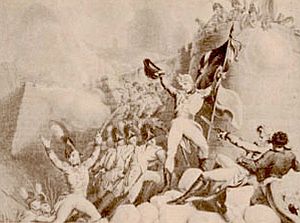Battle of Montevideo (1807) facts for kids
Quick facts for kids Battle of Montevideo |
|||||||
|---|---|---|---|---|---|---|---|
| Part of the British invasions of the Río de la Plata | |||||||
 The British attacking a breach in the defenses of Montevideo. |
|||||||
|
|||||||
| Belligerents | |||||||
| Commanders and leaders | |||||||
| Strength | |||||||
| c. 5000 soldiers | 6000 soldiers | ||||||
| Casualties and losses | |||||||
| 1500 (c. 500 killed) plus 2000 prisoners. | 600 (c. 150 killed and died of wounds). | ||||||
The Battle of Montevideo was an important fight between the British and Spanish Empires. It happened during the Napoleonic Wars. In this battle, British forces took control of the city of Montevideo.
This event was part of the larger British invasions of the River Plate. In the local area, people often remember it as the siege of Montevideo (Spanish: Sitio de Montevideo).
Getting Ready for the Battle
In the early morning of February 3, 1807, about 3,000 British soldiers attacked Montevideo. Their leader was Brigadier General Sir Samuel Auchmuty.
Before the main attack on the city, there was an earlier fight. This happened on January 20, outside the town. It was called the Battle of El Cristo del Cardal, or Battle of Cardal.
During this earlier battle, two British groups, the 60th Rifles and the 95th Foot, fought very well. They moved around the Spanish forces, which helped the British win. About 800 local fighters were hurt or killed. The British had about 70 soldiers hurt or killed.
The Main Attack on Montevideo
After the first fight, Montevideo was surrounded by the British. This is called a siege. The main attack on the city began around 2:00 A.M. on February 3.
For several days before the attack, the British had been firing cannons at the city walls. They aimed at the weakest part of the wall. Once a large hole, called a breach, was made, the soldiers attacked.
The Spanish defenders fired heavily from nearby strong points. They also tried to block the breach with animal hides. This made it very hard for the British to get through. Many British soldiers were hurt as they tried to enter the city.
Captain Renny of the 40th Regiment of Foot was the first to find the breach. Sadly, he was killed trying to get through it. Lieutenant Harry Smith of the 95th Regiment of Foot was the second to find the breach. This was Lieutenant Smith's first time fighting in a war.
Once inside the walls, the British still faced strong resistance. But they slowly spread out and pushed the defenders back. Two important British officers, Lieutenant-Colonel Brownrigg and Lieutenant-Colonel Vassal, were badly wounded during this part of the battle.
British soldiers from different regiments, like the 38th and 40th Foot, joined the attack. Cavalry (soldiers on horseback) and Royal Marines were also part of the force. The British needed to win quickly. This was because Spanish reinforcements were coming from Buenos Aires.
Meanwhile, another British group, the 87th Foot, was waiting at a different city gate. This was the San Pedro gate. When they heard the fighting inside, they couldn't wait for the gate to open. They climbed over the wall instead.
The 87th Foot then attacked the Spanish defenders from behind. During this action, they captured a flag from the Spanish. This flag is now shown in a museum in Northern Ireland.
The 95th Regiment then took over the city's cathedral tower. From there, they used their modern rifles to fire at the main Spanish fortress, the Ciudadela. This, along with the British moving through the city, led the Spanish Governor, Ruiz Huidobro, to surrender.
He surrendered to General Auchmuty around 5:00 A.M. General Auchmuty praised Governor Ruiz Huidobro for defending the city bravely. He also mentioned a French fighter named Hipolite Mordeille, who fought very hard. Mordeille was killed during the defense.
What Happened Next
After the city was captured, there was some looting, but British officers quickly stopped it. By 8:00 A.M., people in the city were going about their normal lives. They were even mixing with the British soldiers.
The British army stayed in Montevideo until September 1807. They left because of an agreement made after British forces lost a battle in Buenos Aires in July 1807. That battle was their second attempt to take control of the Viceroyalty of the Río de la Plata from Spain.
General Auchmuty and his forces were thanked by the British Parliament on April 16, 1807. Also, several British regiments received a special honor called 'Monte Video'. This honor was passed down to the regiments that came after them.
See also
 In Spanish: Sitio de Montevideo (1807) para niños
In Spanish: Sitio de Montevideo (1807) para niños


